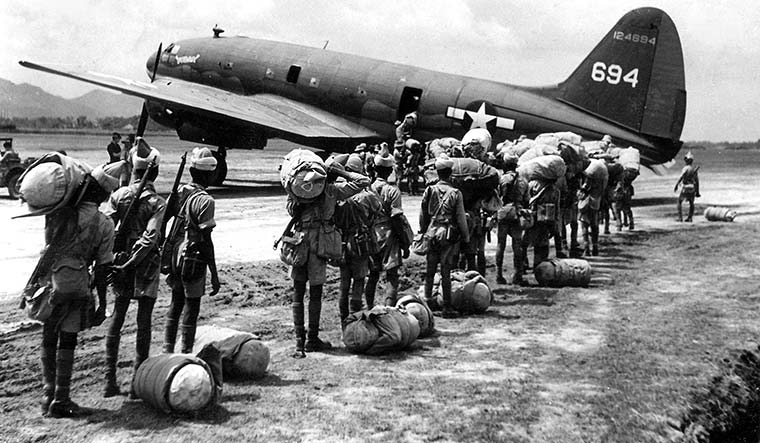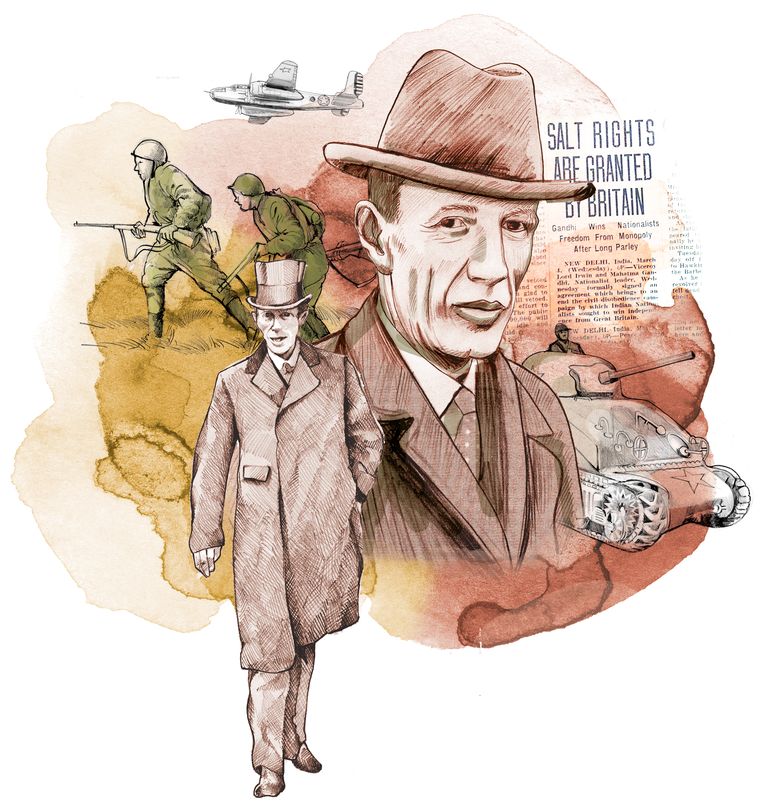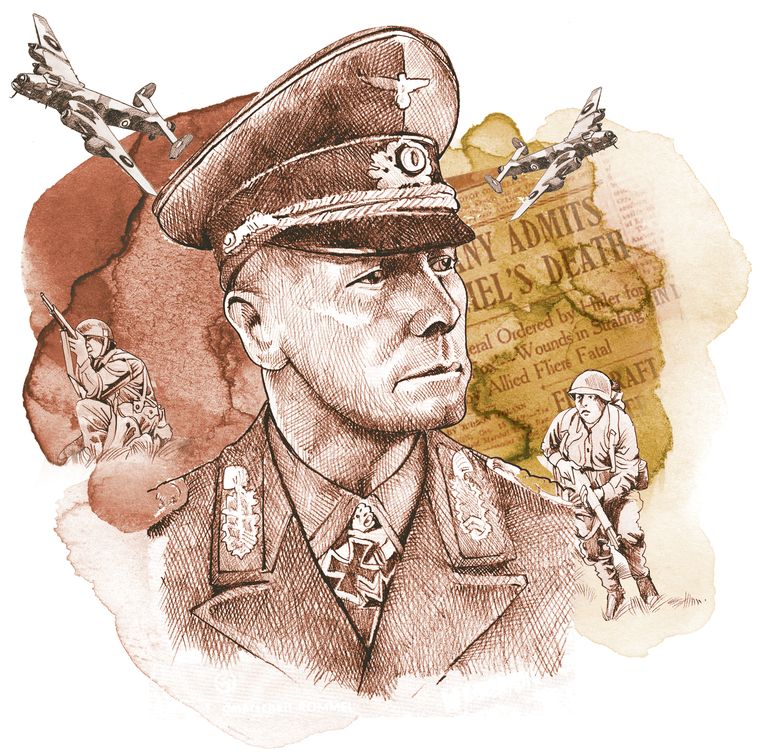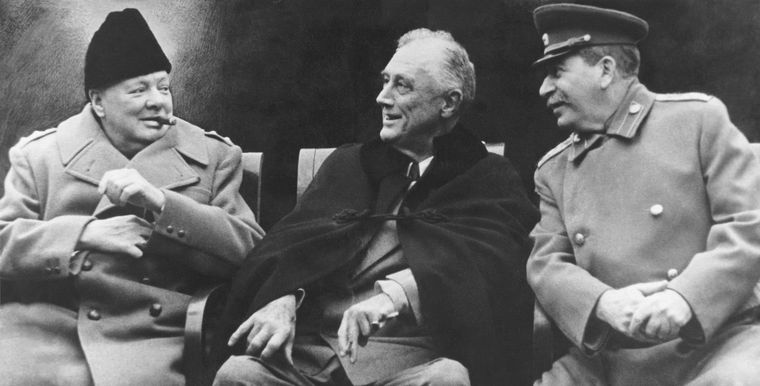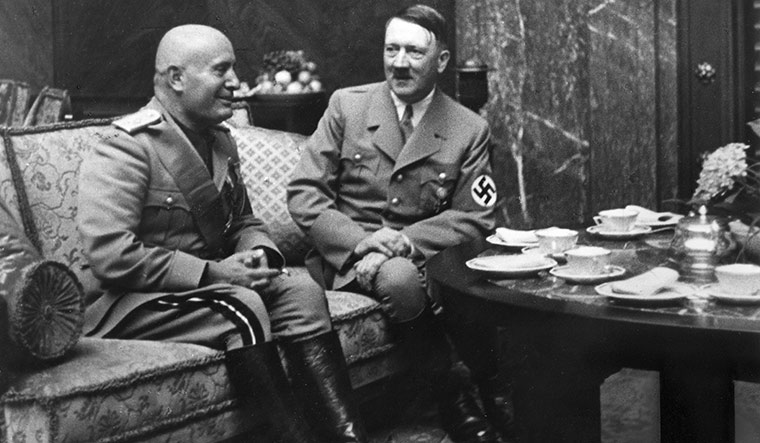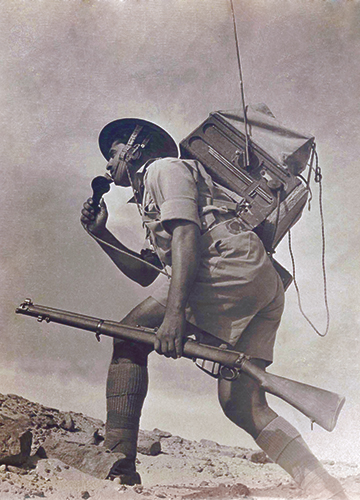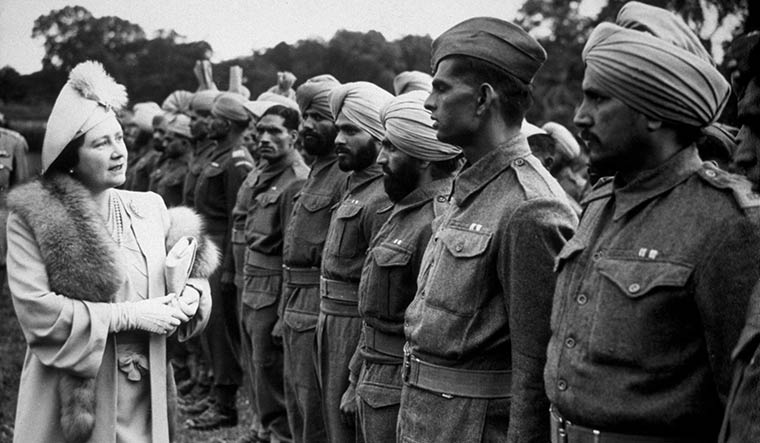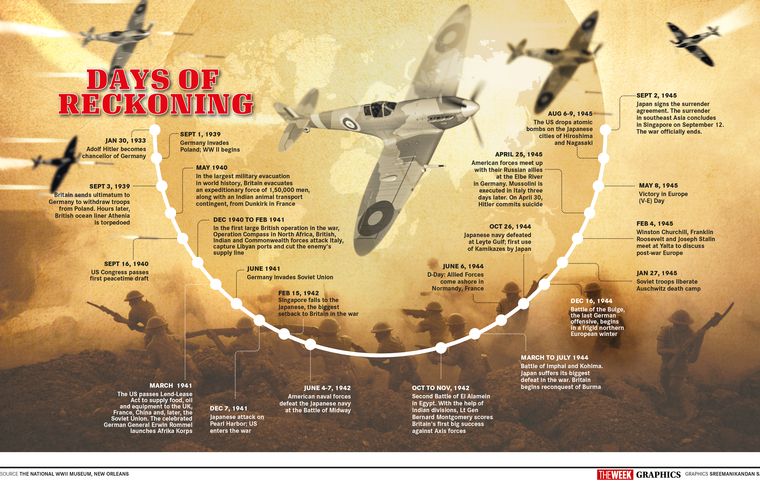It was a former ruler of India who sent the ultimatum that started the war. It was a future ruler of India who received the final document of surrender that officially ended the war. From the beginning to the end, World War II was India’s war as much as it was of any other people.
Let us begin at the beginning. At 4am on September 3, 1939, Lord Halifax sent a telegram from London to Neville Henderson, Britain’s ambassador in Berlin. The cable contained a message for Germany’s foreign minister Joachim von Ribbentrop: Withdraw Germany’s occupation army from Poland. “I have accordingly the honour to inform you,” continued the Halifax cable, “that unless not later than 11am, British summer time, today September 3, satisfactory assurances to the above effect have been given by the German government and have reached His Majesty’s government in London, a state of war will exist between the two countries as from that hour.”
That was perhaps the harshest step that Halifax, a man of peace whom his old friend Mahatma Gandhi had described as “the most Christian and the most gentlemanly” personage, had taken in his eminently successful public life. Born without a left hand, Lord Irwin, as he had been known before he was made the Earl of Halifax, had finally landed the most prestigious job in the world at that time, the secretary of state of Great Britain.
Indeed, as viceroy of India, he had put Gandhi in jail for breaking the salt law, but had soon made amends by receiving the “half-naked fakir” as an equal at the magnificent palace that he had inaugurated in the new imperial capital of New Delhi. The two men had also signed a pact that had led to Gandhi sailing to London for the second Round Table Conference and having an audience with the king-emperor. Though the conference had failed, the Gandhi-Irwin pact had opened the way for political dialogue between Indian leaders and British rulers.
Later, as foreign secretary in the embattled Tory government of Neville Chamberlain, Halifax had fathered the appeasement policy by which Britain watched helplessly while a militarised Germany, under the Austria-born artist Adolf Hitler, was gobbling up country after country in Europe. All along, Halifax had been avoiding a war that he was convinced would not only destroy Britain and her empire, but also wreck the whole of Europe and the free world. His admirers say the appeasement helped Britain gain time to rearm.
Halifax’s assessment was not wrong. The same afternoon after his ultimatum expired, British ocean liner Athenia was torpedoed, killing 112 passengers. Only then did the harsh reality hit the great sea lords of England—that they might still be ruling the world’s waters, but German U-boats were ruling the underwaters. The Battle of the Atlantic opened the same day, and within a month the Royal Navy would lose half a dozen ships.
The dry ground, too, was shaking under Britain’s feet. Most of her land forces were dispersed across Africa and Asia. There was an expeditionary force of about 1,50,000 men in France, but the generals knew that they stood no chance before the German panzers. Finally, the entire expeditionary force, along with an Indian animal transport contingent, would be ferried to safety in May 1940 across the English Channel from Dunkirk, on every little boat that could float, making it the largest military evacuation in world history.
As the hour set by Halifax elapsed, his office sent cables to hundreds of offices across the world. One landed on the desk of the viceroy of India, Lord Linlithgow, in Simla. At 8.30 the same evening (3pm London time, just four hours after Halifax’s deadline expired), Linlithgow went on air pledging India’s wholehearted support to the war effort. The proclamation, done without even a modicum of consultation with Indian leaders, would later prove politically the unwisest step taken by any viceroy (see story on page 48).
No one—not even the viceroy—had any idea how India would fight the war.
At the hour when Linlithgow was going on air, the Indian Army had just 1,60,000 troops, including about 16,000 British officers and men, and 72,000 with the princely states. The Royal Indian Navy had just 1,700 officers and men, and the Indian Air Force had just one squadron with 200 officers and men who were busy quelling a tribal uprising in Waziristan. The squadron was commanded by its first Indian commander Subroto Mukherjee, who would later become the first Indian chief of the IAF; among the officers was Arjan Singh, who would also later head the IAF and become India’s only marshal of the air force. By the time the war ended in 1945, the Indian Army had swelled to “more than two and a half million”, writes Harry Fecitt in Distant Battlefields. “It was the largest all-volunteer army in the history of human conflict.” Close to 25,000 of them perished in the war, 64,000 were wounded and 12,000 went missing.
But at this moment, it was nothing but a small border army. Most of the land and air forces were deployed to guard the northwest from the Russians, who, the British feared, had been coveting India, first under the imperial Tsars and now under the godless communist Joseph Stalin. When the war opened, the Soviet Union was an ally of Germany. Only months earlier had Stalin signed a non-aggression pact with Hitler, and occupied most of eastern Europe. The two dictators, it had appeared, were dividing Europe among themselves, and Stalin would soon be reaching out to Asia, particularly India.
Britain’s position was precarious—alone and friendless with a huge empire to defend. The United States, with its enormous grain granaries and industrial might, offered some hope; but its isolationist politics made it stay neutral in what was perceived to be another European war. The US offered arms, but on cash basis.
Cash was what Britain did not have. Britain’s strength lay in her colonies, the crown jewel being India, where the Linlithgow regime launched a massive recruitment campaign. Indian leaders, despite their non-cooperation, did not try to block it. By late November, the first Indian troops joined the expeditionary force in France, allowing part of the main British force to move north. By then, Stalin had conquered Finland.
Early in 1940, Italian dictator Benito Mussolini met Hitler on the Austrian border and promised to enter the war “at an opportune moment”. In April, Norway and Denmark fell to Germany. On May 10, Hitler shocked the world by invading Belgium, Luxembourg and the Netherlands and attacking Britain’s staunchest ally, France. Chamberlain resigned the same day, giving way to an all-party government under the India-hating Winston Churchill.
It was Mussolini who drew first blood with Indians. He chose his “opportune moment” in June 1940 to strike in North Africa, held by Sir Claude Auchinleck’s Eighth Army with the 4th and 5th Indian divisions under it. The overall command of the region was vested in the one-eyed Archibald Wavell, a general who wrote poems when he was not planning strategies. (He had lost his left eye in the Battle of Ypres in World War I.)
Both men took an instant liking to the Indians. Before the war would end, the two would come to India, both to command the army here and Wavell to also rule India as the viceroy who would pave the way for a constitutional transfer of power through an interim government.
We will leave the two Indian divisions under these two men for the time being, and see what was happening in Europe.
The picture was getting dismal in Europe. As regime after regime fled to London, Churchill ordered Operation Dynamo by which 3,40,000 Allied troops, including four Indian mule transport companies, were ferried to England from Dunkirk on warships, sloops and country boats. On June 25, France surrendered. Hitler was now the overlord of the entire western Europe, leaving the east, the Baltics and Finland to Stalin.
In July 1940, Hitler asked his general staff to plan an invasion of Britain, a venture that several European kings and dukes, including Napoleon, had planned but never succeeded since 1066. In what came to be known as the Battle of Britain, history’s greatest air war, German bombers pounded the cities of Britain day and night.
It was into this dismal picture that Indians entered. Italy had a vast empire in East Africa from where they threatened British territories and invaded British Somaliland. The first major Allied action in Africa, Operation Compass, was against the Italians in Sidi Barrani area of Egypt. The 4th Indian Division, commanded by Major General Noel Beresford-Peirse, was pressed into battle in December 1940; they pushed out the enemy in three days, capturing 38,300 prisoners, 237 guns, 75 tanks and 1,000 vehicles. The 5th Indian Division, under Major General Lewis Heath and comprising only two brigades, defeated the Italians at Agordat in Eritrea and pushed them out of Keren. But the Italians took up defensive positions on the mountains 70km east. The Indians soundly defeated them at Ad Teclesan, where Subedar Richpal Ram (4/6 Rajputana Rifles) won a posthumous Victoria Cross. The Italians surrendered at Asmara in Eritrea on April 8, 1941.
In short, it was the Indian forces that liberated the city of Addis Ababa in April, paving the way for Ethiopian Emperor Haile Selassie to return to his homeland. Ever grateful, Sudan and Ethiopia would later contribute money for setting up the National Defence Academy near Pune. The main building of the NDA is still called Sudan Block.
By now, the Italians fighting in Eritrea regrouped in Amba Alagi. The 5th Indian Division stormed the heights from the north, while a British force pushed from the south. On May 18, the Italian viceroy and the entire Italian force surrendered to the Indian division. Even Churchill conceded: “The whole empire has been stirred by the achievement of Indian forces in Eritrea.” In the subsequent mop-up operation, second lieutenant P.S. Bhagat (later lieutenant general) won the Victoria Cross.
Meanwhile, another threat arose in the Middle East. A pro-German junta, led by Rashid Ali, seized power in Iraq, from where Britain was getting most of its oil to run the war machine. With all her forces tied down in Europe and Africa, Britain sought India’s help. In mid-1941, the 8th Indian Division reached Basra in Iraq, followed by the 10th division. They occupied Baghdad and secured the oil fields, winning the theatre honour of ‘Iraq 1941’. Another Indian brigade, along with Australians and the Free French Forces, captured Damascus in a bold night attack and secured Syria and Lebanon.
Embattled in Africa by the Indians and the Allied forces, Mussolini sought German aid. Hitler sent his celebrated general, Erwin “the Desert Fox” Rommel, a master tactician who was respected even by his British enemies, as head of the Afrika Korps. Rommel struck in March 1941. A brilliant action by the 3rd Indian Motor Brigade delayed him at Meikili on April 6, which allowed an entire Australian division to withdraw to Tobruk in Libya. Rommel besieged Tobruk, forcing the Allies to withdraw further. In December, Rommel defeated the Allied force, including 4th Indian, but their subsequent actions forced him to withdraw to El Agheila.
In May-June 1942, the 10th Indian Division joined the Commonwealth forces in the first Battle of El Alamein in Egypt. Soon the 4th Division, which had gone to Syria, too, returned and helped in the famous victory of Bernard Montgomery over Rommel in the second Battle of El Alamein. An exuberant Churchill declared: “This is not the end. It is not even the beginning of the end. But it is, perhaps, the end of the beginning.”
It was not just the genius of Montgomery (his father had been one of the greatest administrators of Punjab and had lent his name to a district in West Punjab, now in Pakistan) alone that turned the tables. Hitler was losing interest in Africa; his eyes had by now been on a larger pie—the vast territories of Russia, its oil in the Caucasus and the cherry cities of Moscow and Leningrad. If he could conquer Russia, he would be the master of the entire European landmass, save perhaps the little island of Great Britain.
On June 22, 1941, Hitler committed a Napoleonic folly—he invaded the Soviet Union in a three-pronged operation. The blitzkrieg of tanks faced no resistance for miles and miles. Taken by surprise and speed, the Russian defences crumbled in town after town. More than five lakh were captured prisoner within weeks, and starved or tortured to death.
In July, Stalin ordered his people to burn their crops, bridges and buildings and withdraw, so that the invading Germans would not seize them. By autumn, the German forces had begun the siege of Leningrad that would last 872 days, and were almost sighting the spires of Moscow. Russia was starved of food, fuel and ammunition. They needed immediate supplies, especially oil, as did Britain. Most of the oil had been coming from Persia, and now that was under threat from the advancing German army. An Anglo-Soviet invasion of Iran was planned, but where would the forces come from? Again the British looked to India.
The 8th and 10th Indian Divisions, the 2nd Indian Armoured Brigade and a British armoured brigade, all fighting in North Africa, were pressed into an incredibly rapid invasion of Iran in August 1941. Two Indian battalions made an amphibious crossing of the river Shatt al-Arab and captured the oil rigs of Abadan. Eight battalions of British and Indian troops under Major General William Slim, who would later defend India from the Japanese, advanced from Khanaqin in Iraq into the Naft-i-Shah oilfield in Iran and on towards the Pai Tak Pass. The pass was taken on August 27, and two days later the defenders surrendered. It was all swift, and fairly easy, but very vital to the further conduct of the war. As Auchinleck, who had commanded Indians in the Middle East and would later become the commander-in-chief of India, said, the British “couldn’t have come through both wars if they hadn’t had the Indian Army”.
The operation would give relief not only to the British, but also to starving Russia. The job of opening a supply line to Russia from the Middle East was also entrusted to the Indian command now. The Persia and Iraq Force (PAI Force), consisting mostly of Indian troops, developed ports, roads, river and canal routes from the Persian Gulf to the Arctic reaches of Russia, through which tens of thousands of soldiers carried 62,000 tonnes of aid. Later, in 1944, a grateful Presidium of the Supreme Soviet of the USSR would award the prestigious Orders of the Red Star to Subedar Narayan Rao Nikkam and Havildar Gajendra Singh Chand of the Indian Army Service Corps.
By late 1941, the German advance, though slowed, was reaching the outskirts of Moscow. Stalin moved his government further east, but he stayed in Moscow with his celebrated general, Georgy Zhukov, who, too, moved his troops behind the city and waited for the snow to fall. Into this freezing picture, now entered another enemy and a friend. And that enemy was going to pose a direct threat to India. With that, the war also would become a world war.
On December 7, Japanese planes bombed the US Pearl Harbour. America’s entry into the war, with all her industrial might, was a big relief to Russia, which had been worried that Japan would attack them from the east. Japan’s attack on the American port revealed that her interests were in the Pacific. Relieved, Zhukov moved his Siberian divisions, the world’s best snow-warriors, to fight the Germans around Moscow.
For Indians and the British, however, this also brought new dangers. Japan, the Allies realised, was coveting the Pacific and also Britain’s Asian empire, of which India was the crown jewel. It also meant that thousands of Indian lives were in danger. For, most of Britain’s Asian empire—from distant Hong Kong to next-door Burma—was garrisoned mostly by Indian troops.
Within four hours of the attack on Pearl Harbour, Japan struck at not only the British garrison in Hong Kong, which included 5/7th Rajput Regiment and the 2/14th Punjab Regiment, but also Malaya, where the bulk of the British army was Indian. On December 11, the Japanese invaded Burma.
The Rajputs and the Punjabis in the Hong Kong garrison fought bravely for 18 days before surrendering. Bearing the brunt of the ferocious Japanese attack on Malaya that began December 8, were the 9th and the 11th Indian Divisions, the 12th Indian Infantry Brigade and several independent battalions. They tried to stop the Japanese at Jitra, Kampar and Slim River in Malaya; two Indian brigades which had arrived as reinforcement in January 1942 joined them at Muar. More than 3,000 of the 4,000 men in these brigades perished.
Malaya looked a lost cause, yet the troops fought bravely. But the biggest blow came in Singapore, considered the eastern gate of the empire. Despite the brave fight put up by the 9th and 11th Indian Divisions, Singapore fell to the superior might of the Japanese on February 15, 1942. About 55,000 Indians were captured by the Japanese. The fall of what was called Fortress Singapore, like the disaster in Mesopotamia in World War I, was the hardest blow that the British suffered in the war. In both, it was Indian troops who suffered the most. The surrender signalled that the sun was going to set on the empire in the east. An alarmed Churchill exclaimed at the fall of Singapore: “Australia is threatened; India is threatened.”
Naturally, the subsequent battles were the most desperate ever fought in any war in modern times. Military historians say that in terms of ferocity, the battles in the east—on the islands and atolls of the Malayan archipelago, the vast malaria-infested plantations of Malaya, and the dense jungles of Burma—were the most desperate, for both the British and Indian regiments. A battalion of 15th Punjab were in Kuching, the capital of Sarawak, ruled by a British rajah since James Brooke set up a kingdom styling himself rajah in the mid-19th century. The Punjabi bid to hold an airfield cost them 230 men on the Christmas eve of 1941. The survivors crossed into Dutch Borneo to fight the Japanese under a Dutch command for three months before being captured.
Into Burma, it was not an attack but a massive invasion by the Japanese on December 11. The 17th Indian Division held the Japanese at the Bilin River for two days in February 1942 in close-quarter fighting. As the Japanese outflanked and encircled them, they fell back wading through the jungle track for about 50 kilometres to Sittang bridge. In the pitched battle that followed, they lost most of their guns, vehicles and other heavy equipment. The remnants made their way to Pegu in March.
In April, the 48th Armoured Brigade, along with the 48th Indian Brigade and 1st Burma Division, could finally inflict some damage on the Japanese. By the time the battle ended, the troops were too exhausted to even hold on. The high command in India tried once more to hold on in Burma with a bold campaign in Arakan, beginning December 1942. But with neither the Indian nor the British troops having been trained for jungle warfare, the campaign flopped. The repeated defeats affected the morale, and stories of Japanese invincibility began spreading among the troops and the public. About 12,000 of the 40,000 Indian prisoners of war who were captured in Malaya or surrendered at Singapore joined Mohan Singh’s First Indian National Army, and subsequently Subhas Chandra Bose’s forces.
By now, London decided that their Indian high command was not capable of training and equipping the army for jungle war. A new Supreme Allied Command for South East Asia was created under Admiral of the Fleet Lord Mountbatten, leaving the India command in charge of internal security. General William Slim, who commanded the entire force in Burma, concluded that it was time to take a last stand for India.
But where? It would have to be at the eastern gates of India itself, he decided. The entire army in the Arakan was airlifted with American help to Imphal and Kohima. This far and no further, Slim decided.
Slim’s grit paid off finally. As the British and the Indians stood defending India, the Japanese infiltrated through the gaps, crossed the Kalapanzin River, turned west and south, and attacked the headquarters of the 7th Indian Division in February. In what came to be known as the Battle of the Admin Box, one of the most ferocious battles ever fought, the 5th, 7th and 26th Indian, 81st West Africa Division, and 36th British Infantry Division dug in and fought back.
For Indians on both sides, it was a war for their country. The defenders at Imphal and Kohima were told that they were now, for the first time, fighting to save their motherland from unknown tyrants of the east. On the attacking side too, the INA troops were told that they were seeking to liberate their motherland from the European enslavers. To the great glory of India, both sides fought hard.
Hitting like typhoons from land and air, the defenders mauled the Japanese. The ferocity of the defence took the Japanese by surprise; though more Indian and British soldiers were killed in the battle than the Japanese, for the first time the Japanese realised that capturing India, even with the help of the INA, was not going to be a walkover as they had thought.
The brilliant defence of the Admin Box boosted the morale of the Indians and the British. It shattered several myths, the primary one being that the Japanese were some sort of supermen who could not be defeated. It also proved that regimental loyalty in the Indian Army was as strong a bonding as were national loyalty and ethnic bonding. If many troops had switched over to the INA during the Burma campaign, many more had stayed on with their buddies, platoons, battalions and regiments, even risking their lives. And by the time the Japanese arrived at Imphal and Kohima, many of them had also been trained in jungle warfare through the famous Chindit operations of Orde Wingate (see page 38).
So when the attack on Imphal came, the defenders were in fairly high spirits. The 17th, 20th, 23rd Indian Divisions, 50th Indian Parachute Brigade and 254th Indian Tank Brigade defended Imphal and Sangshak from March till July 1944, yielding not even an inch, and finally pushing back the enemy into Burma with heavy losses.
Almost simultaneously, the Japanese were pushing at Kohima, too, where the 50th Indian Parachute Brigade, 5th and 7th Indian and 2nd British Divisions captured a ridge that was dominating the area. The Japanese held on to the road that was leading to Imphal for more than a month from May 16. Finally, the defenders blasted them out, and captured the road, which was a major supply line for the army. The battle ended on June 22, when the troops from Kohima and Imphal met on the road at Milestone 109. Finally, the Japanese abandoned their invasion plans and began a retreat into Burma. As Wavell would remark later, Kohima was where “the Japanese were routed and their downfall really began”.
Slim decided that his victory would be complete only if he reconquered Burma. He sent his Indians and British troops after the Japanese. Probably inspired by the memory of the 70,000 who had fallen in Malaya and 1,75,000 in Burma as dead or wounded, they hit the enemy hard at Meiktila and Mandalay from January to March 1945. They proved to be as good as the Japanese in jungle warfare, and superior to them in the use of armour and mechanised forces in jungles. Even Slim was surprised at the ferocity with which the Indians hit the enemy.
The twin victories at Meiktila and Mandalay virtually decimated the Japanese army in Burma. The subsequent operation to capture Rangoon, Operation Dracula, was a walkover for the Indian divisions.
There were still pockets of fierce resistance. In the Battle of Ramree Island in southern Burma, which had been captured by the Japanese in 1942, the 26th Indian Division fought for six weeks in early 1945.
By now the Allies were gaining the upper hand in both the Pacific and Europe. General Douglas MacArthur, a brilliant tactician, had led the American forces ‘leap-frogging’ from island to island, kicking out the Japanese. In Europe, the Allied forces, under the overall command of Dwight Eisenhower, had landed in Normandy and also pushed up from southern Italy, fighting their way into Rhineland. Meanwhile, Zhukov’s Russians, who had suffered the most in the war, were having their revenge by pushing the Germans back into Germany and Berlin.
As the Russian forces were finally pounding Berlin, Hitler knew the game was over. He married his mistress Eva Braun on April 30, 1945, retired to his bunker, where she swallowed poison, and shot himself. Seven days later, at 9:20pm, his nominated successor, Admiral Karl Dönitz, signed the instrument of surrender.
The guns went silent all over Europe, and celebrations broke out. Wandering incognito among the London revellers were two pretty girls named Elizabeth and Margaret, much like the bored princess who sought a few nightly adventures in Roman Holiday.
But there was still no revelry for the Indian soldiers fighting in Asia. As Churchill said in his radio broadcast next afternoon, “We may allow ourselves a brief period of rejoicing [as Japan] remains unsubdued.” In Washington, DC, Harry Truman, who had succeeded Franklin Roosevelt as president, said, it was “a victory only half won”.
The two were now after the Japanese. As Burma was conquered, the British made plans to retake Malaya and Singapore. The 25th Indian Division with 3 Commando Brigade had joined in the first large-scale amphibious operations in southeast Asia in January 1945. They had occupied Myrbaw and Ruywa. In April, the division was withdrawn to south India to prepare for Operation Zipper. They were chosen for the assault landing role in the invasion of Malaya.
But Truman decided to cut everything short. After the Battle of Okinawa in April, in which 82,000 US troops and 1,17,000 Japanese soldiers and citizens were killed, he decided enough was enough. From Potsdam on July 26, he ordered the Japanese to “surrender or suffer prompt and utter destruction”. Japan rejected the ultimatum.
On August 6, a USAF B-29 Superfortress bomber Enola Gay, named after the mother of its pilot Colonel Paul Tibbets, dropped the atom bomb Little Boy on Hiroshima, killing about 80,000 innocent people. Even before the mushroom cloud dissipated, Truman issued another warning to Japan to surrender or “expect a rain of ruin from the air, the like of which has never been seen on this earth”. On August 9, Stalin invaded Japan. Within hours, another of Truman’s bombs, Fat Man, fell on Nagasaki. The next day, Tokyo agreed to surrender on one condition: Please let our emperor remain in place.
The big three, now the rulers of the universe, agreed.
On August 14, the Allied governments announced the surrender of Japan. On September 2, the Japanese generals officially surrendered to General MacArthur on board USS Missouri, berthed in Tokyo Bay.
For India, however, there were a few more days of war left. The 5th Indian Division had sailed from Trincomalee and Rangoon to retake Singapore in Operation Tiderace. The fleet arrived in Singapore on September 4, 1945. The 23rd and 25th Divisions landed in Malaya on September 9.
On September 12, exactly six years and nine days after Gandhi’s friend Halifax had sent the ultimatum to Ribbentrop, the war officially ended. Jawaharlal Nehru’s future friend Admiral Lord Louis Mountbatten, the supreme Allied commander for southeast Asia, accepted Japan’s surrender in the Municipal Building of Singapore, now known as City Hall. Representing the Indian Army at the ceremony with General Slim was Brigadier K.S. Thimayya, the only Indian officer who had been given an operational command in the war. He had led the 8/19th Hyderabad Regiment against the Japanese in the Burmese jungles, and would later save Kashmir and command the Indian Army.
Thus, the war that had started with a cable sent out by a former ruler of India ended with a document received by a future ruler of India, who would also bring the curtain down on the colonial phase in India’s history. But the armed forces that they left behind would march on to greater glories.


